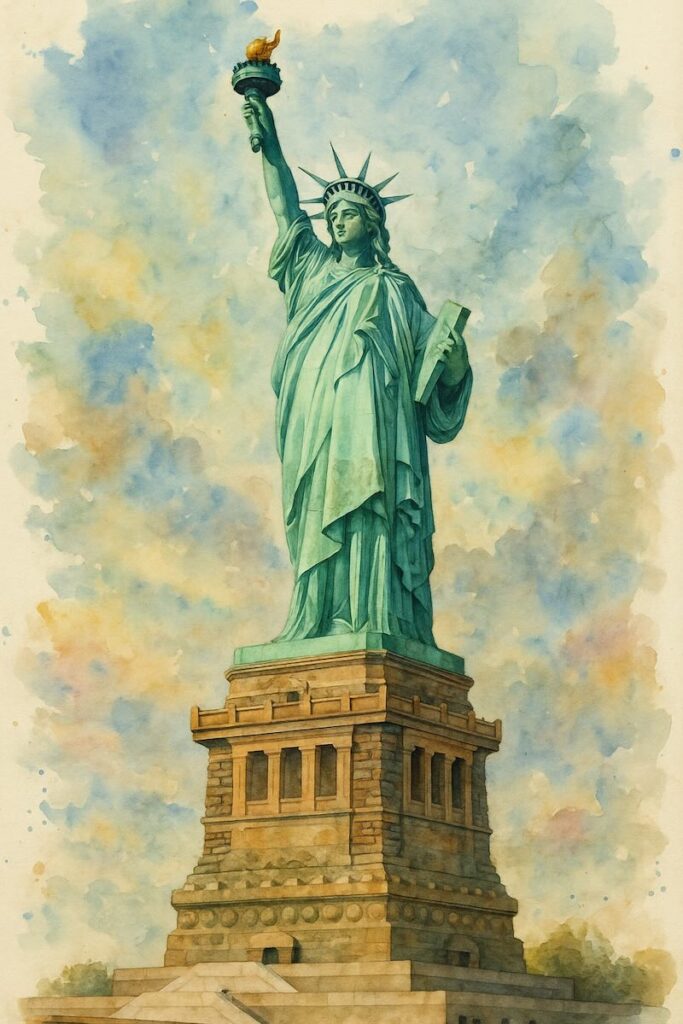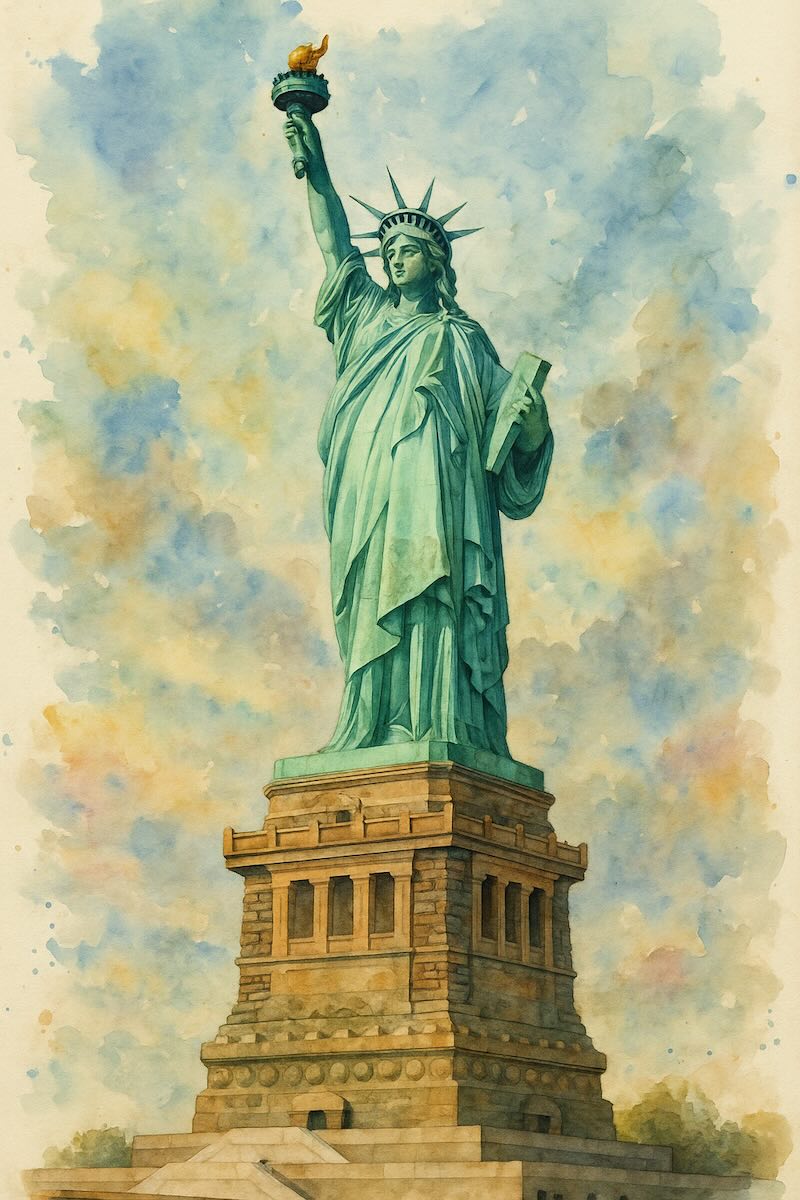Level 1 Reader
450 Words
A Big Green Lady
The Statue of Liberty is a big, green statue. She stands in New York City, in the United States. She is very tall and very famous. Many people know her. The statue looks like a woman. She wears a long dress. She holds a torch in her right hand. She holds a book in her left hand. She has a crown on her head. The crown has seven points. The seven points are for the seven seas and seven continents.
A Gift from France
The Statue of Liberty came from France. France gave the statue to the United States. It was a gift. France and the United States are friends. France gave the statue in 1886. That was many years ago. French people made the statue. The statue came to the U.S. by boat. It came in many pieces. People in the U.S. put it together.
What She Means
The Statue of Liberty is not just a statue. She is a symbol. She means “freedom.” In the past, many people came to America by boat. They wanted a better life. They were poor. They were afraid. When they saw the statue, they felt happy. They were in a new country. They had hope.
Her Size
The statue is very big. She is over 90 meters tall with her base. Her finger is longer than your arm! Her nose is longer than your hand! You can walk inside the statue. You can take stairs to the crown. From the crown, you can see the water and the city. The view is very nice.
Visiting Today
Today, many people visit the Statue of Liberty. They come from all over the world. They take a boat to Liberty Island. They look at the statue. They take pictures. They smile. There is a museum too. People learn about the statue and her history. The Statue of Liberty is very old. But she is strong. She is still standing. She still says: “Welcome.”
Her Torch
The statue’s torch is very bright. It means “light” and “hope.” It says, “Come and find freedom.” The torch is gold in color. It shines in the sun. Long ago, it was a lighthouse. It helped boats at night. Today, it is not a real light. But it still shows the way.
She Is Special
The Statue of Liberty is on coins and stamps. She is in books, movies, and songs. She is a symbol of America. She is special to many people. She says: “You are free here.” “You can dream here.” “You can begin again.” The big green lady is more than a statue. She is a friend to the world.
Level 2 Reader
506 Words
A Gift from France
The Statue of Liberty is one of the most famous symbols of the United States. It stands on Liberty Island in New York Harbor and welcomes people arriving by sea. The statue was a gift from France to the United States in 1886. It was given to celebrate the 100th anniversary of American independence.
The French people wanted to show their friendship. They also believed in the same ideas as the Americans: freedom and democracy. A French sculptor named Frédéric Auguste Bartholdi designed the statue, and Gustave Eiffel, the man who later built the Eiffel Tower, helped with the structure inside.
Building the Statue
The Statue of Liberty was built in pieces in France. It took many years to finish. Each part was made of copper and shaped carefully. When all the parts were ready, they were sent to the United States by ship.
In New York, American workers built the base for the statue. Then, they put the statue together on top. The whole statue was completed and officially opened on October 28, 1886. There was a big celebration, and people were excited to see the new monument.
What She Looks Like
The Statue of Liberty is a woman wearing a long robe. She holds a torch high in her right hand. In her left arm, she carries a tablet. On the tablet, the date July 4, 1776 is written — the day the United States became independent.
She also wears a crown with seven points. These points represent the seven continents and the seven seas. It means liberty for all people around the world. At her feet, there are broken chains, which show freedom from slavery and oppression.
The statue is very large. From the base to the top of the torch, it is about 93 meters tall. People can climb 354 steps inside to reach the crown.
A Symbol of Hope
For many years, immigrants came to the United States by ship. The first thing they saw was the Statue of Liberty. To them, the statue was a sign of hope and a new life. It meant they had reached a land of freedom and opportunity.
Near the statue is Ellis Island. It was the place where immigrants were checked before entering the country. Between 1892 and 1954, more than 12 million people passed through Ellis Island. The Statue of Liberty became a symbol of their journey.
The Statue Today
Today, the Statue of Liberty is one of the most popular tourist attractions in the United States. People from all over the world come to visit. They can take a boat to Liberty Island and walk around the statue. Many visitors also go to the museum inside and learn about the history of the statue and the people who made it.
In 1984, the statue became a UNESCO World Heritage Site. It is protected as a cultural treasure. The statue is more than just a monument — it is a symbol of freedom, friendship, and the hope for a better future.
Level 3 Reader
570 Words
The Statue of Liberty: A Symbol of Freedom
When most people think of New York City, one image immediately comes to mind: the Statue of Liberty. Towering over Liberty Island in New York Harbor, she has become one of the most iconic symbols of freedom, democracy, and hope in the world. But how did this giant copper figure come to stand there, and what does she really mean?
A Gift from France
The Statue of Liberty was a gift from the people of France to the United States. It was meant to celebrate the centennial of American independence and to symbolize the strong friendship between the two countries. French sculptor Frédéric Auguste Bartholdi designed the statue, and Gustave Eiffel—the engineer who would later build the Eiffel Tower—helped with the internal metal framework.
Construction of the statue began in France in the early 1870s. Once completed, it was disassembled and shipped to New York in 1885 in over 300 separate pieces. It was then reassembled on a massive pedestal, which had been constructed on what was then called Bedloe’s Island.
A Grand Unveiling
On October 28, 1886, the Statue of Liberty was officially unveiled. The ceremony was grand, featuring speeches, parades, and naval salutes. President Grover Cleveland accepted the statue on behalf of the United States. From that day forward, Lady Liberty, as she came to be known, stood tall as a welcoming figure to immigrants arriving by sea.
What She Represents
The statue is rich in symbolism. Lady Liberty holds a torch in her right hand, representing enlightenment. In her left hand, she carries a tablet inscribed with the date July 4, 1776—the day the Declaration of Independence was signed. At her feet are broken chains, signifying the end of oppression and tyranny.
Her crown has seven spikes, which represent the seven continents and the seven seas, highlighting the universal concept of liberty. Although many people think of her as green, she was originally a shiny reddish-brown color. The greenish hue we see today is the result of natural oxidation of the copper surface over time.
A Beacon to Immigrants
Perhaps the most powerful aspect of the Statue of Liberty is the emotional response it inspires. For millions of immigrants arriving in America during the late 19th and early 20th centuries, she was the first thing they saw. Her image promised the possibility of a better life, where personal freedom and opportunity awaited.
At the base of the statue is a bronze plaque with the famous poem “The New Colossus” by Emma Lazarus. Its lines, “Give me your tired, your poor, / Your huddled masses yearning to breathe free,” became a powerful message of welcome and inclusion.
Preservation and Tourism
Over time, the statue suffered from weather and pollution, so several restoration projects have taken place. The most significant was for her centennial in 1986, when both the interior and exterior were repaired. Today, the Statue of Liberty is a major tourist attraction, drawing millions of visitors each year. Many climb the 354 steps to reach the crown, enjoying a panoramic view of New York City.
Conclusion
More than just a statue, Lady Liberty continues to stand as a powerful reminder of the ideals on which the United States was founded—freedom, hope, and the possibility of a better future. Whether viewed up close or from afar, her torch still shines brightly for people around the world.
Extensive Listening
Level 1 Audio
Level 2 Audio
Level 3 Audio
Natural Discussion
AWS Polly & Google Notebook LM
La Estatua de la Libertad

Lectura nivel 1
425 Palabras
Una Gran Dama Verde
La Estatua de la Libertad es una estatua grande y verde. Está en la ciudad de Nueva York, en los Estados Unidos. Es muy alta y muy famosa. Muchas personas la conocen. La estatua parece una mujer. Lleva un vestido largo. Sostiene una antorcha en su mano derecha. Sostiene un libro en su mano izquierda. Tiene una corona en la cabeza. La corona tiene siete puntas. Las siete puntas representan los siete mares y los siete continentes.
Un Regalo de Francia
La Estatua de la Libertad vino de Francia. Francia dio la estatua a los Estados Unidos. Fue un regalo. Francia y los Estados Unidos son amigos. Francia dio la estatua en 1886. Eso fue hace muchos años. Personas francesas hicieron la estatua. La estatua vino a Estados Unidos en barco. Vino en muchas piezas. Personas en Estados Unidos la armaron.
Lo Que Ella Significa
La Estatua de la Libertad no es solo una estatua. Es un símbolo. Significa “libertad”. En el pasado, muchas personas vinieron a América en barco. Querían una vida mejor. Eran pobres. Tenían miedo. Cuando vieron la estatua, se sintieron felices. Estaban en un nuevo país. Tenían esperanza.
Su Tamaño
La estatua es muy grande. Mide más de 90 metros con su base. ¡Su dedo es más largo que tu brazo! ¡Su nariz es más larga que tu mano! Puedes entrar en la estatua. Puedes subir escaleras hasta la corona. Desde la corona, puedes ver el agua y la ciudad. La vista es muy bonita.
Visitar Hoy
Hoy, muchas personas visitan la Estatua de la Libertad. Vienen de todas partes del mundo. Toman un barco a la Isla de la Libertad. Miran la estatua. Sacan fotos. Sonríen. También hay un museo. Las personas aprenden sobre la estatua y su historia. La Estatua de la Libertad es muy vieja. Pero es fuerte. Todavía está de pie. Todavía dice: “Bienvenidos”.
Su Antorcha
La antorcha de la estatua es muy brillante. Significa “luz” y “esperanza”. Dice: “Vengan y encuentren libertad”. La antorcha es de color dorado. Brilla al sol. Hace mucho tiempo, fue un faro. Ayudaba a los barcos en la noche. Hoy, no es una luz real. Pero todavía muestra el camino.
Ella Es Especial
La Estatua de la Libertad está en monedas y estampillas. Está en libros, películas y canciones. Es un símbolo de América. Es especial para muchas personas. Ella dice: “Aquí eres libre.” “Aquí puedes soñar.” “Aquí puedes comenzar de nuevo.” La gran dama verde es más que una estatua. Es una amiga para el mundo.
Lectura nivel 2
542 Palabras
Un regalo de Francia
La Estatua de la Libertad es uno de los símbolos más famosos de los Estados Unidos. Está en la Isla de la Libertad, en el puerto de Nueva York, y da la bienvenida a las personas que llegan por mar. La estatua fue un regalo de Francia a los Estados Unidos en 1886. Se dio para celebrar el centenario de la independencia de Estados Unidos.
El pueblo francés quería mostrar su amistad. También creían en las mismas ideas que los estadounidenses: la libertad y la democracia. Un escultor francés llamado Frédéric Auguste Bartholdi diseñó la estatua, y Gustave Eiffel, el hombre que más tarde construyó la Torre Eiffel, ayudó con la estructura interna.
La construcción de la estatua
La Estatua de la Libertad se construyó por partes en Francia. Tomó muchos años terminarla. Cada parte estaba hecha de cobre y fue moldeada con cuidado. Cuando todas las piezas estuvieron listas, se enviaron a los Estados Unidos en barco.
En Nueva York, trabajadores estadounidenses construyeron la base para la estatua. Después, montaron la estatua sobre ella. Toda la estatua se completó y se inauguró oficialmente el 28 de octubre de 1886. Hubo una gran celebración, y la gente se emocionó al ver el nuevo monumento.
Cómo es ella
La Estatua de la Libertad es una mujer que lleva una túnica larga. Sostiene una antorcha en alto con su mano derecha. En su brazo izquierdo, lleva una tabla. En la tabla está escrita la fecha del 4 de julio de 1776 — el día en que Estados Unidos se independizó.
También lleva una corona con siete puntas. Estas puntas representan los siete continentes y los siete mares. Significa libertad para todas las personas del mundo. A sus pies, hay cadenas rotas, que muestran la libertad frente a la esclavitud y la opresión.
La estatua es muy grande. Desde la base hasta la punta de la antorcha, mide unos 93 metros. Las personas pueden subir 354 escalones por dentro para llegar hasta la corona.
Un símbolo de esperanza
Durante muchos años, los inmigrantes llegaron a los Estados Unidos en barco. Lo primero que veían era la Estatua de la Libertad. Para ellos, la estatua era un símbolo de esperanza y una nueva vida. Significaba que habían llegado a una tierra de libertad y oportunidades.
Cerca de la estatua está la Isla Ellis. Era el lugar donde revisaban a los inmigrantes antes de entrar al país. Entre 1892 y 1954, más de 12 millones de personas pasaron por la Isla Ellis. La Estatua de la Libertad se convirtió en un símbolo de su viaje.
La estatua hoy
Hoy en día, la Estatua de la Libertad es una de las atracciones turísticas más populares de los Estados Unidos. Personas de todo el mundo vienen a visitarla. Pueden tomar un barco hasta la Isla de la Libertad y caminar alrededor de la estatua. Muchos visitantes también van al museo que está adentro para aprender sobre la historia de la estatua y de las personas que la hicieron.
En 1984, la estatua se convirtió en Patrimonio de la Humanidad de la UNESCO. Está protegida como un tesoro cultural. La estatua es más que un monumento — es un símbolo de libertad, amistad y esperanza para un futuro mejor.
Lectura nivel 3
644 Palabras
La Estatua de la Libertad: Un símbolo de libertad
Cuando la mayoría de la gente piensa en la ciudad de Nueva York, una imagen viene inmediatamente a la mente: la Estatua de la Libertad. Elevándose sobre la Isla de la Libertad en el puerto de Nueva York, se ha convertido en uno de los símbolos más icónicos de la libertad, la democracia y la esperanza en el mundo. Pero ¿cómo llegó esta gigantesca figura de cobre a estar allí y qué significa realmente?
Un regalo de Francia
La Estatua de la Libertad fue un regalo del pueblo de Francia a los Estados Unidos. Fue concebida para celebrar el centenario de la independencia estadounidense y simbolizar la fuerte amistad entre los dos países. El escultor francés Frédéric Auguste Bartholdi diseñó la estatua, y Gustave Eiffel—el ingeniero que más tarde construiría la Torre Eiffel—ayudó con la estructura interna de metal.
La construcción de la estatua comenzó en Francia a principios de la década de 1870. Una vez terminada, fue desmontada y enviada a Nueva York en 1885 en más de 300 piezas separadas. Luego fue ensamblada sobre un pedestal enorme que había sido construido en lo que entonces se llamaba la Isla Bedloe.
Una gran inauguración
El 28 de octubre de 1886, la Estatua de la Libertad fue inaugurada oficialmente. La ceremonia fue grandiosa, con discursos, desfiles y saludos navales. El presidente Grover Cleveland aceptó la estatua en nombre de los Estados Unidos. Desde ese día, la Dama Libertad, como se la llegó a conocer, se mantuvo erguida como una figura de bienvenida para los inmigrantes que llegaban por mar.
Lo que representa
La estatua está llena de simbolismo. La Dama Libertad sostiene una antorcha en su mano derecha, que representa la iluminación. En su mano izquierda lleva una tabla con la inscripción del 4 de julio de 1776—la fecha en que se firmó la Declaración de Independencia. A sus pies hay cadenas rotas, que simbolizan el fin de la opresión y la tiranía.
Su corona tiene siete puntas, que representan los siete continentes y los siete mares, subrayando la idea universal de la libertad. Aunque muchas personas la ven como verde, originalmente era de un color marrón rojizo brillante. El tono verdoso que vemos hoy es el resultado de la oxidación natural del cobre con el tiempo.
Un faro para los inmigrantes
Quizás el aspecto más poderoso de la Estatua de la Libertad es la respuesta emocional que inspira. Para millones de inmigrantes que llegaron a América a finales del siglo XIX y principios del XX, fue lo primero que vieron. Su imagen prometía la posibilidad de una vida mejor, donde la libertad personal y las oportunidades los esperaban.
En la base de la estatua hay una placa de bronce con el famoso poema “The New Colossus” de Emma Lazarus. Sus versos, “Dadme a vuestros rendidos, a vuestros pobres, / a las masas apiñadas que anhelan respirar libres”, se convirtieron en un poderoso mensaje de bienvenida e inclusión.
Conservación y turismo
Con el tiempo, la estatua sufrió los efectos del clima y la contaminación, por lo que se han llevado a cabo varios proyectos de restauración. El más importante fue para su centenario en 1986, cuando se repararon tanto el interior como el exterior. Hoy en día, la Estatua de la Libertad es una importante atracción turística que recibe a millones de visitantes cada año. Muchos suben los 354 escalones para llegar a la corona y disfrutar de una vista panorámica de la ciudad de Nueva York.
Conclusión
Más que una estatua, la Dama Libertad sigue siendo un recordatorio poderoso de los ideales sobre los que se fundaron los Estados Unidos: la libertad, la esperanza y la posibilidad de un futuro mejor. Ya sea vista de cerca o desde lejos, su antorcha sigue brillando con fuerza para las personas de todo el mundo.
Escucha extensiva
Nivel 1 audio
Nivel 2 audio
Nivel 3 audio
Discusión natural
AWS Polly & Google Notebook LM


